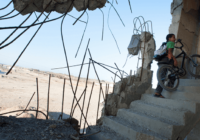In the present situation, any solution deemed sustainable in science cannot be truly sustainable in the Gaza Strip, or even in Palestine.
This past spring, I was sitting in one of the environmental policy and public health classes of my graduate studies program, and the topic of discussion was water issues and solutions around the world. The Gaza Strip was mentioned, almost inevitably considering that close to 95% of groundwater in the area is undrinkable. I was asked to comment as the only Palestinian in my program. As I spoke, I remember thinking: “I have reiterated these statistics so many times. Palestine is fed up. Gaza is fed up. Gaza is marching.”
Every Friday since March of this year, when the Great March of Return launched, I check the notifications on my phone for different news outlets and expect to read about the Gaza Strip — the number of casualties and injured, the names and the stories of these individuals. Every Friday, my expectations are met. There is news about Gaza, and the news is never good and never different. Even now, if one were to Google “Gaza Strip,” one will inevitably come across a headline about “clashes” and “protests,” and even a piece titled “What is Gaza?”
On November 11, Israeli forces carried out a “special operation” that resulted in a military raid of the Gaza Strip. What resulted was the killing of an Israeli soldier, the murder of seven Palestinians, Gaza’s sky set on fire by bombs, the haunting photograph of a wedding dress hanging from the closet of a destroyed apartment and, finally, a ceasefire agreement that history indicates will be short-lived. This news, too, is never new for Palestinians. It is disappointing, heart-breaking even, but never new.
What I did notice — other than the resignation of the Israeli Defense Minister Avigdor Lieberman in protest to the ceasefire — was that Israeli citizens took to the streets to protest the ceasefire. Israelis equated the cessation of hostilities with weakness of their military — a military that sits on an annual budget close to $20 billion. This is reminiscent of news articles and photographs published about Israelis watching and celebrating bombs dropping on an open-air prison that is the Gaza Strip during the summer of 2014.
I scroll through photographs of tires burning and banners in Hebrew protesting the ceasefire, and I wonder where were these protests, rather than celebrations, when homes, hospitals, schools and universities in the Gaza Strip were bombarded, the death toll rising every few hours in 2008, 2012 and 2014? Where were the protests to call on the end of the siege on Gaza and the end of the occupation of Palestine? In an eloquent op-ed, Mariam Barghouti makes the observation that although Israel besieges Palestinians, it is also besieging Israelis to the tragic reality that they reinforce, without a second thought, all in the name of security. It is the narrative of security and of the “two sides” reiterated by Israel that further perpetuates the occupation of Palestine and moves individuals further away from ending it.
In my class, students were asked to prepare policy briefs. One of mine was on promoting hydroponics in the Gaza Strip as a sustainable method to conserve water. Hydroponics is a soilless farming technique where crops are grown in nutrient solutions as opposed to traditional farming on land, and the United Nations World Food Program has encouraged its use in various low and middle-income countries. Benefits include using less water and gaining a source of income, while challenges include high initial costs and energy use. Furthermore, in the case of Gaza, space and movement restrictions on farmers and materials present a central challenge.
After a few weeks of researching and writing on the topic, I found myself presenting at Xavier University College of Pharmacy 11th Health Disparities Conference. The questions from academics, researchers and students all revolved around: What is Gaza? Where is Gaza? Why Gaza? It was with one medical student that I had a deep conversation about Gaza and Palestine, and it was because he asked, “Can hydroponics truly be sustainable?” I answered “No.”
In the present situation, any solution deemed sustainable in science cannot be truly sustainable in the Gaza Strip, or even in Palestine. Solutions are only truly sustainable when root causes are addressed — when the big “P” policies, namely the Israeli occupation — are addressed. Palestinians are resilient individuals, and despite knowing this, they attempt sustainable solutions such as utilizing hydroponics. However, the reality is that even the most sustainable solutions are hindered due to the restrictions posed by the Israeli occupation.
This cannot be ignored by scientists, health professionals and lawmakers when addressing the dire statistics in Gaza: Half the population is food insecure; 80% of the population relies on international aid; treatments in hospitals are restricted because medicines are restricted. In two years, Gaza will be unlivable. Scientists, health professionals and lawmakers must remember that while specific solutions are hypothesized and implemented, these solutions need to be accompanied by a larger call to end the occupation.
The views expressed in this article are the author’s own and do not necessarily reflect Fair Observer’s editorial policy.
Support Fair Observer
We rely on your support for our independence, diversity and quality.
For more than 10 years, Fair Observer has been free, fair and independent. No billionaire owns us, no advertisers control us. We are a reader-supported nonprofit. Unlike many other publications, we keep our content free for readers regardless of where they live or whether they can afford to pay. We have no paywalls and no ads.
In the post-truth era of fake news, echo chambers and filter bubbles, we publish a plurality of perspectives from around the world. Anyone can publish with us, but everyone goes through a rigorous editorial process. So, you get fact-checked, well-reasoned content instead of noise.
We publish 2,500+ voices from 90+ countries. We also conduct education and training programs
on subjects ranging from digital media and journalism to writing and critical thinking. This
doesn’t come cheap. Servers, editors, trainers and web developers cost
money.
Please consider supporting us on a regular basis as a recurring donor or a
sustaining member.
Will you support FO’s journalism?
We rely on your support for our independence, diversity and quality.






